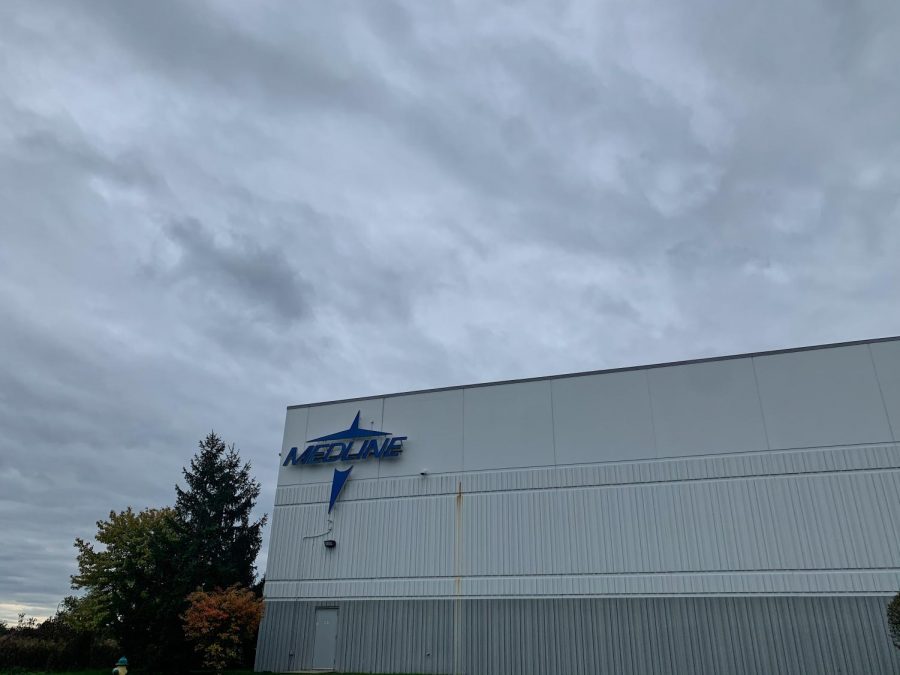Local Medical Plants Emitting Toxic Chemicals in Lake County
Lawsuits have been filed against Medline for their use of toxic chemicals that can lead to cancer, but there are no federal regulations for the toxic chemicals in use.
It was recently announced that Medline Industries and Vantage Specialty Chemicals have been polluting the air with a toxic gas, ethylene oxide, in Lake County for several decades, according to the Lake County Health Department.
Both medical companies use ethylene oxide (EtO) to sterilize their medical equipment because of the overall efficiency of the gas being able to diffuse through the layers of packaging. EtO is difficult to detect because it takes form as a colorless and odorless gas. EtO is released into the air as a steam along with carcinogens, which increase risks of cancers, such as leukemia, stomach cancer, lung cancer and breast cancer. It also can damage the nervous system as well as cause genetic mutations and reproductive defects, concluded the Agency for Toxic Substances and Disease Registry.
With the plants releasing the gas, the effects of the toxic chemical have been most heavily felt within the Gurnee and Waukegan areas, approximately 10 miles north of Libertyville. Four lawsuits were filed against both Medline and Vantage in late August.
Waukegan resident Dawn Rex sued both companies after her 3-year-old son, Samuel Dolcimascolo, was diagnosed with leukemia three months ago. During a town hall meeting on Oct. 2 at the College of Lake County, she addressed the ATSDR with anger: “My 3-year-old son is battling for his life. I shouldn’t even be here.”
Patty Bennett, a Gurnee resident, also filed a lawsuit against both companies due to her leukemia diagnosis in 2016. Both plaintiffs attest they acquired cancer due to the toxic air surrounding their homes; they live within a three-mile radius of both facilities.
There are also multiple schools located around the medical plants, which raises potential health concerns for children. “What’s top-of-mind to me is children, including infants and toddlers, who will have the longest-term impacts,” local resident Pat O’Keefe, of Gurnee, stated at the town hall meeting.
The four lawsuits do not cover all suspected consequences of the toxic materials. The National Air Toxics Assessment is a screening tool used by the state to identify large concentrations of pollutants in the air and calculates the health risks associated with the toxins. According to NATA’s website, in their 2014 screening, the test found more than 100 cancer cases per million people in the Gurnee and Waukegan townships; in the surrounding communities, such as Libertyville, the rate was 25-50 cancer cases per million people.
The assessment also exposed that Medline had released 3,058 pounds of EtO and Vantage 6,412 pounds in 2014 alone. Willowbrook, a town also affected by EtO emissions in 2019, recently enacted a new legal limit for Sterigenics (another medical plant), which is now 85 pounds per year. Although the number is significantly lower from the 2014 NATA screening, it still poses a threat to the health of the surrounding community. In an email to the Illinois Environmental Protection Agency on Aug. 13, Medline officials stated, “We have learned no additional information that would cause us to revise our 2014 number.”
While the issue may seem to merit federal legislation, there is an explanation for why action has not been taken at a national level. According to the IEPA, the legal limit of EtO gas released into the air is 0.02 µg/m3, which is 2 millionths of a gram per cubic meter air. The IEPA director, John Kim, however, claims, “It is not a regulatory number; it’s a guidance number.” As a result, the companies do not have to comply with these guidelines.
The IEPA and ATSDR were only informed of the air pollution in Lake County last November, after both facilities were forced to publish reports on their high levels. Air sample locations around the Gurnee and Waukegan areas taken in June were 10.0 µg/m3, around 500 times higher than the advisable limit. The IEPA declared that due to a lack of regulatory limit, neither company can be legally convicted in court. IEPA decided to instead issue a permit that monitors the gas and regulates it so that companies can’t keep releasing such high levels of EtO into the air.
The majority of ethylene oxide emissions do not however impact Libertyville. Mrs. Jennifer Kahn, an environmental science teacher, explained that “[the emissions] diffuse into the environment the farther you get away [from the chemical plants] so that the levels that are considered dangerous become less significant pretty quickly.” She added that, “generally the wind direction that we see is not towards Libertyville and typically we see the weather moving off to the east, so over Lake Michigan.” This wind essentially moves the EtO away, therefore, Libertyville is protected from most of the emissions, she said.
Dr. Lonny Lemon, superintendent of Oak Grove School, explained, “Testing in Green Oaks has not been done by the IEPA, so we don’t have any data to tell us if there is a potential safety issue in our community.” He described that NATA has issued future screenings that will give residents an updated report on emissions in the area. He added that “everyone is anxiously awaiting the results of those tests.”
Looking towards the future, Medline and Vantage officials state they have enacted new restrictions that will limit emissions by 99.9 percent in future years, according to the Daily Herald. Many bills have been passed by state legislators allowing local governments to install their own regulations. Groups of Lake County residents have also come together to form organizations to ban EtO all together, creating petitions and protesting to their local mayors.













